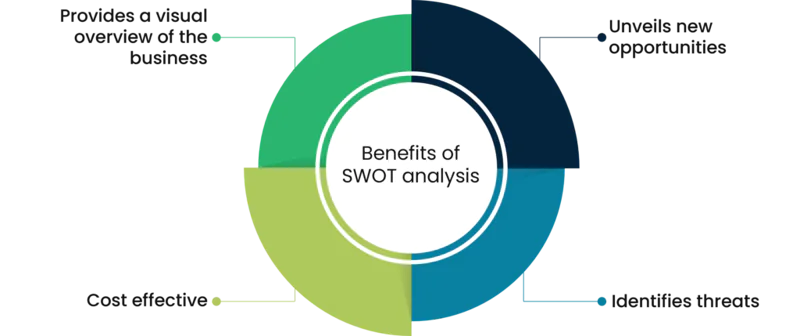In today’s complex and dynamic business landscape, procurement teams face mounting pressures from global supply chain disruptions to rising operational costs. With growing complexities in logistics and vendor relationships, companies need a structured approach to navigate uncertainty. Enter supply chain SWOT analysis—a proven, strategic framework that offers clarity and direction.
At SpendEdge, we recognize the immense value that supply chain SWOT analysis brings to procurement organizations. By examining internal strengths and weaknesses, alongside external opportunities and threats, this method empowers companies to uncover actionable insights and make smarter decisions. It’s not just about identifying risks it’s also a pathway to procurement opportunity analysis, cost reduction, and enhanced resilience.
What is supply chain swot analysis?
A supply chain SWOT analysis is a strategic planning methodology used to evaluate the key drivers influencing supply chain performance. By analyzing strengths, weaknesses, opportunities, and threats, organizations gain a 360-degree view of their operations. This is crucial in understanding market conditions, cost dynamics, and supplier landscapes.
As global supply chains grow in complexity, the risk of disruption also intensifies. Extended routes, more transfer points, and decentralized management increase the chances of inefficiencies. This challenge is compounded when companies outsource operations or integrate new volumes to lower costs.
These realities demand a deeper understanding of operational gaps—and that’s where a supply chain SWOT analysis becomes invaluable. It helps leaders focus on reducing cost structures, improving vendor collaboration, and proactively addressing weak points across the chain.
Introduction to SWOT analysis
Now that we’ve laid a sturdy groundwork in supply chain management, let’s delve into how SWOT analysis can enrich the strategic decision-making process. SWOT analysis stands as a stalwart framework empowering organizations to scrutinize their internal strengths and weaknesses, alongside external opportunities and threats.
Think of SWOT analysis as a finely-tuned microscope honing in on various facets of your supply chain, enabling you to pinpoint critical areas ripe for leverage or enhancement. By scrutinizing the internal strengths and weaknesses, along with external opportunities and threats, organizations can attain a comprehensive grasp of their supply chain’s present state and future potential.
When embarking on a SWOT analysis, meticulous consideration of each element is paramount. Supply chain managers employ this framework to illuminate pathways for procurement excellence, bolstering the components of the supply chain and fortifying strategic decisions in supply chain management.
By conducting a SWOT analysis, companies can assess their internal strengths and weaknesses, as well as identify external opportunities and threats. This allows for a comprehensive understanding of the cost-efficient supply chain, enabling organizations to leverage their strengths and address areas of weakness. Additionally, a SWOT analysis facilitates fact-based analysis and data analysis, providing insights into market dynamics and procurement strategies. Ultimately, this enables companies to optimize their cost-benefit analysis and maximize opportunities within their product or service categories, even in the face of limited supplier options.
Wondering how to identify discrepancies in the supply chain? Request a free proposal and know how our experts can precisely conduct a SWOT analysis for your organization and guide you with customized solutions.
Key Benefits of Supply Chain SWOT Analysis for Procurement Organizations

1. Cost-Effective and Practical
One of the key advantages of supply chain SWOT analysis is its practicality. It doesn’t require external consultants anyone with visibility into inventory, vendor competencies, and internal processes can contribute. This makes it an affordable and insightful tool for procurement teams.
It also enhances supplier relationship management, risk mitigation, and resource allocation, helping procurement align with broader business goals like environmental sustainability and tech integration.
2. Offers Visual Clarity
A SWOT matrix visually maps strengths, weaknesses, opportunities, and threats, giving a clear overview of the supply chain’s performance. This visualization supports contract negotiations, strategic sourcing, and contingency planning.
Combined with procurement opportunity analysis, it informs smarter vendor selections, lead-time optimization, and cost-saving initiatives—all while reducing operational friction.
3. Unveils New Growth Opportunities
Today’s digital era brings constant opportunities for supply chain improvement. Using SWOT as a part of your strategic toolkit can help uncover innovations in supplier engagement, service expansion, and sourcing strategy.
Organizations that pair SWOT findings with procurement opportunity analysis often identify hidden areas for value creation—especially in terms of cost reduction, inventory optimization, and negotiation leverage.
4. Helps Identify and Manage Threats
A critical benefit of SWOT is its ability to highlight both current and future risks. These may include supplier issues, product discontinuation, material shortages, or broader market instability.
Supply chain SWOT analysis allows organizations to develop mitigation strategies, adapt procurement approaches, and preserve business continuity. It’s also effective in handling resource limitations, enhancing partnerships, and preventing technology-related inefficiencies.
Want to know how SWOT analysis can help your organization in analyzing the effectiveness of the supply chain? Get in touch with our experts today!

Conclusion
In the world of supply chain and procurement management, a well-executed supply chain SWOT analysis isn’t just a tool it’s a strategic imperative. It enables companies to examine their operations holistically, align sourcing decisions with business priorities, and identify value creation opportunities.
When integrated with procurement opportunity analysis, SWOT becomes a powerful lens for uncovering supplier gaps, mitigating risks, and planning for growth. Whether you’re looking to reduce costs, strengthen vendor relationships, or navigate market volatility, this analysis framework offers clarity and insight you need to stay competitive.





